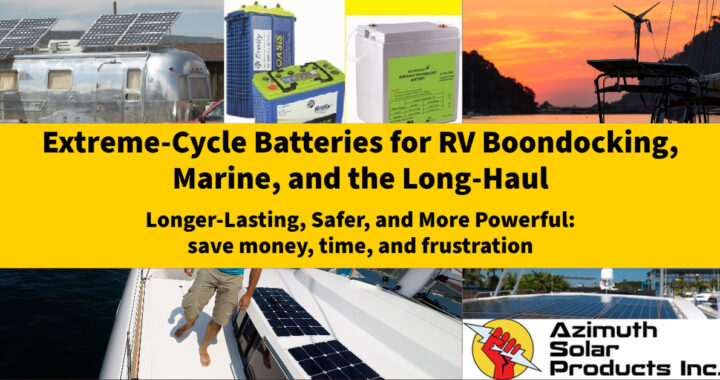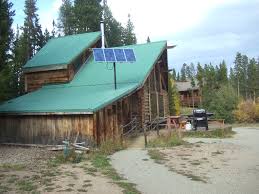Extreme-Cycle Batteries for RV Boondocking, Marine, and the Long-Haul
Longer-Lasting, Safer, and More Powerful: they can save you money, time, and frustration
Every so often, it’s time to replace your deep-cycle batteries for your RV, sailboat, or off-grid battery bank. This rarely happens at a convenient time or location; often it’s unexpected, after a long hot period, or freezing temperatures. Even with regular maintenance; water top-ups, and electrolyte balancing, the best flooded lead-acid batteries will eventually succumb to electrolyte break-down and sulfation due to age. GEL and AGM batteries eliminate maintenance, but cost more and can degrade quicker.
Battery replacements jump twice a year, during the hottest weeks of summer and during the coldest weeks of winter (or when people start taking their RVs and boats out of storage).
When batteries start to fail, you may find yourself running your generator more often, or having critical equipment fail overnight, like refrigerators, CPAP, communications and radios, bilge and water pumps, winches, autopilot, fresh water makers, or lighting.
There are new marine and RV battery choices with greater reliability and range to suit your budget and keep your equipment and appliances running. These can provide over 5 times the lifespan of regular marine and RV batteries, without freezing, drying-out, off-gassing, or needing frequent maintenance. They are already being adopted for marine and off-grid use and increasingly for remote telecom relay towers, industrial, and military use. Their longer lifespans also mean lower lifetime costs since they can last for well over a decade.
Battery Lifecycles:
A battery’s lifespan is measured by its “Cycle-Life”; how many times it can be charged and discharged before it wears out. Normally, lead-acid batteries are only discharged up to 50% of their power capacity, to improve their overall lifespan. Discharging them 100% can reduce their cycle life to as little as 10%. Low-maintenance, sealed batteries (GEL and AGM), can range from 500 – 1200 cycles @ 50% DoD. If the batteries are not recharged promptly, their usable capacity, measured in Ampere-hours (Ah), will be quickly reduced by sulfation. (If you don’t refill the “gas-tank”, it will shrink!) A 100Ah battery can turn into an 80Ah battery, or become useless if left too long without a recharge. As some experts say, “Batteries don’t die, they’re murdered!” Excessive hot or freezing temperatures can also significantly reduce the capacity and lifespan of lead-acid batteries. This means, at best, your deep-cycle batteries will need to be replaced every 3 years of daily deep-cycling or every 6-9 years for seasonal use. Many people, however, have purchased deep-cycle batteries and expected them to last for a decade of boondocking, only to kill them quickly with too high or freezing temperatures or by over-discharging them. To prevent freezing, most people remove their batteries from their RV or sailboat, and store them in a warm indoor location. This can mean hours of awkward heavy lifting, with the additional delights of spills and corrosion to clean up.
Some RV owners and almost all boat owners have their RV batteries inside. How many of you have to move cushions, empty storage cupboards or shelves, just to add distilled water (another thing to store), to your flooded batteries, every couple of weeks or so?
The solution is to use a more durable battery for Marine and RV use, especially at anchor, boondocking, and dry camping. Better batteries help you avoid over-reliance on shore power and generators!
Our Top Two Picks for the Best Batteries for RVs, Marine and Camping:
1. Silicon-Dioxide (SiO2) aka Lead Crystal Batteries:
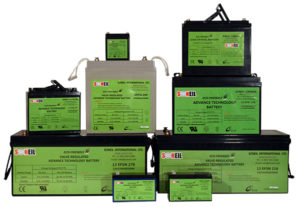
A variety of sizes in both 6V and 12V are available for a wide range of applications.
Originally developed in the 1970’s by the US military, to be a liquid-free “dry” battery that could literally be shot and not leak its contents; these went from an early-stage, low-output weakling to a hard hitting contender, using modern nanomaterials.
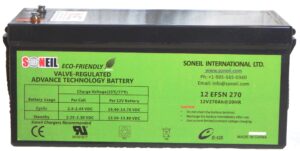
270Ah 12V SiO2 Deep Cycle 8D Battery
Silicon-dioxide (SiO2) aka lead crystal or crystal batteries boast among the best temperature ranges and high cycle-life of any lead-acid battery. Averaging 2,800 cycles at 50% depth of discharge, these outperform most premium batteries by over double their lifespans. By reducing sulfuric acid content by over 95%, these contain virtually no liquid inside to freeze, spill, or off-gas. The result is a battery that resists sulfation and corrosion, even if fully discharged. SiO2 batteries have an impressive -40C/F to +65C/149F temperature range; making them ideal for remote arctic or desert locations. The non-corrosive electrolyte forms a nearly solid, non-toxic crystalline material that cannot spill or leak and is more environmentally friendly in this 99% recyclable battery. Since there is no fluid that can freeze and expand, the batteries are highly resistant to freezing conditions and can be mounted on their sides for normal use. The non-corrosive electrolyte also prevents sulfation and premature loss of battery capacity, so these batteries can be discharged 100% without loss of capacity. The SiO2 batteries can charge in about half the time of normal deep-cycle batteries, conserving generator fuel and reducing your exposure to carbon-monoxide and noise, enabling you to adhere to strict generator run time rules in many RV parks.
These batteries are available in a wide variety of sizes and voltages. Common sizes for RV and Marine, include 6V 260Ah GC2 size, 100Ah 12V G27 size, 12V 108Ah G30H and 12V 216Ah or 12V 270Ah 8D sizes.
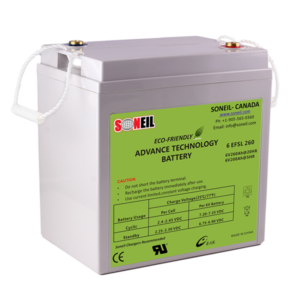
6V, 260Ah RV/Golf Cart GC2 Battery
SiO2 batteries are perfect for winter or summer high temperature use in RV’s, motorhomes, vintage trailers, sailboats, fishing & marine use, scooters, off-grid homes, cabins, cottages, and golf carts. Also excellent for outdoor applications; such as remote monitoring, security systems, trail cams, emergency lights, mobile equipment, water & sump pumps, electric fences, UPS backup systems and communication relays.
- Temperature range: -40C/F to +65C/149F Great for sub-freezing conditions to high desert heat.
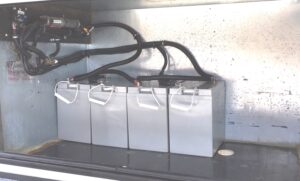
bank of 6V 260Ah SiO2 batteries in an RV
- Charge time: Fast 4Hrs from fully depleted. (0.25C rate)
- Cycle Life: 2,800 Cycles @ 50%, 1,500 @ 80%. Can be discharged 100% and recover full capacity
- Shelf-life: 2yrs without trickle-charging
- Max Discharge Rate: Up to 9C (9 x rated Ah capacity <5 Secs) High surge cranking power.
2. Firefly Carbon Foam Batteries:

Firefly Oasis Carbon Foam G31 and L16 Batteries
Oasis Carbon Foam batteries were developed in the R&D labs of heavy equipment manufacturer Caterpillar Tractors (CAT) in 2000. Firefly Oasis batteries were quickly adopted by the heavy equipment, industrial markets. Firefly Energy bought the patents and manufacturing in 2010, and made these batteries available for the electric vehicle, luxury yacht, and marine markets in 2012. Azimuth Solar Products opened up distribution for North American off-grid and consumer use in 2018.
These batteries deliver lithium-ion performance at lower cost!
The microcell carbon technology resists the sulfation that reduces battery life, while increasing the charge-plate surface area for much faster charging (1C rate), high current output, and deeper discharge capability. Carbon Foam batteries can recover from sitting partially charged for extended periods without corrosion damage (often the killer of regular lead acid batteries). Boasting a similar cycle-life of lithium batteries, without the drawbacks of charging damage in sub-freezing temperatures they rival lithium ion at lower cost; however, they do not have the lighter weight and smaller size of li-ion.
Firefly batteries come in two sizes of ruggedized battery: Group 31 multipurpose 12V, 116Ah, and L16 – 4V,450Ah power-storage battery. These are designed as AGM, sealed, zero-maintenance batteries with the advantages of extreme cycle-life, faster charging from fully discharged @ 1hr vs @ 7-10Hrs for standard batteries.
|
|
G31: 12V 116Ah | L16: 4V 450Ah |
|
Temperature Range |
-20C / -4F to +50C / 131F |
-20C / -4F to +50C / 131F |
|
Charge Time |
Very Fast: 1 hour from fully depleted (up to 1C rate) |
|
|
Cycle Life |
3,900 Cycles @ 50% |
4,900 Cycles @ 50%, |
|
Discharge Range |
Can be discharged 100% and recover full capacity |
|
|
Shelf life |
2 Years without trickle charging |
|
|
Cold Cranking Amps (CCA) |
720A |
n/a |
Applications: Marine (sailboats, catamarans, yachts, runabouts, fishing, trolling), RV (boondocking, dry camping, trailer, motorhomes), Off-Grid, water-well pumps, power back-up, electric vehicles, commercial, and heavy equipment batteries.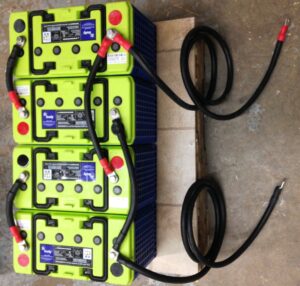
Road Vibration:
Starter, low cost AGM and flooded batteries do not do well in portable use. The road vibration overflexes the lead plates and spills the corrosive liquid ( flooded batteries), prematurely killing the batteries. Both SiO2 batteries and Firefly carbon foam batteries can withstand road vibration and rough sea turbulence much better than their flooded competitors.

Other Common Battery Types:
Standard Lead-Acid Batteries:
These batteries come in flooded, AGM and Gel. Flooded batteries need a watering system, proper venting and regular maintenance to prevent sulfation damage. They are prone to freezing damage when temperatures drop below -18C if not kept fully charged, and can suffer from electrolyte loss and break down in hot conditions. Checking and topping off the electrolyte levels adds additional complexity and danger of splashing or spills. The vapours from these batteries tend to corrode nearby terminals and electronics. AGM and Gel batteries eliminate the need for regular maintenance and ventilation at a higher price, but still have temperature and lifespan limitations. Well known batteries of this type include Trojan, Outback, Interstate and Rolls-Surrette. The cycle life of these batteries commonly range from 600- 1400 cycles @ 50% depth of discharge.
Nickel-Iron Batteries
These batteries are very heavy and bulky and are not suitable for marine or RV use.
Lithium-ion Batteries
Lithium-ion batteries can charge quickly and have a great cycle-life capability, BUT they can only be charged above 0C/32F. Unless lithium cells are above freezing temperatures, lithium ions will electroplate onto the anodes, lowering capacity, and permanently damaging your batteries. A lithium Battery Management System (BMS) will shut off charging at freezing temperatures, so for wintertime, your batteries could be either quickly drained, or destroyed if not kept in a heated location. Lithium Ion batteries used in vehicles have a heating system built into the power pack to overcome this, however, this can drain your batteries in cold conditions. Another consideration for Lithium-ion Batteries is that BMS systems for most DIY or retail li-ion batteries (Battleborn, Superstart) are often quite limited in their power output. You may have a large battery bank but may only be able to draw 50-100A current per battery on a continuous basis. Most lithium batteries are not well suited as starter batteries for this reason (marine use).
Final Thoughts
Having batteries that can go long intervals without charging or maintenance, and that can last several lifetimes of a regular battery; will save you money, time, and possibly your life, in the long-run. Silicon Dioxide (SiO2), Carbon Foam or Lead Carbon Batteries are our picks for the Best Batteries for RV batteries, Marine batteries and Camping batteries. New chemistries like silicon dioxide / lead-crystal batteries, carbon foam / lead carbon batteries are worth considering; their advantages are worth the higher up front cost. These improved batteries have ultra-long, deep-cycle lives, don’t off-gas or require maintenance, have long stand-by charges and have greater temperature ranges.

